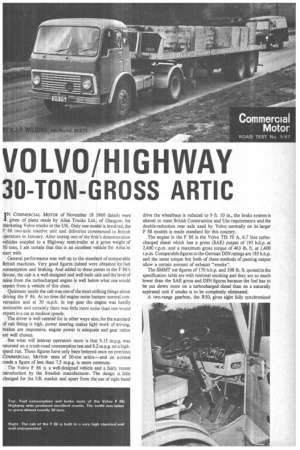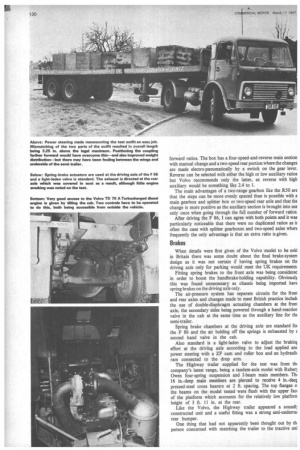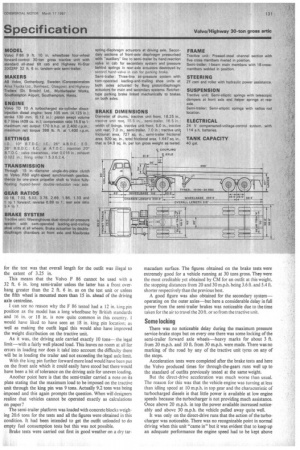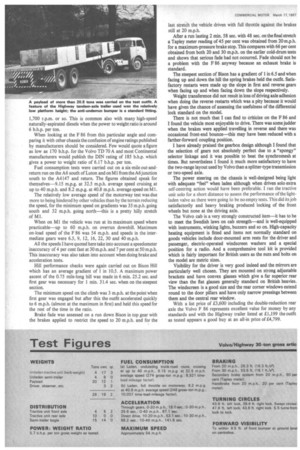VOLVO/HIGHWAY
Page 139

Page 140

Page 141

Page 142

If you've noticed an error in this article please click here to report it so we can fix it.
30-TON-GROSS ARTIC
TN COMMERCIAL MOTOR of November 18 1966 details were
given of plans made by Ailsa Trucks Ltd., of Glasgow, for marketing Volvo trucks in the UK. Only one model is involved, the F 86 two-axle tractive unit and deliveries commenced to British operators in January. After testing one of the firm's demonstration vehicles coupled to a Highway semi-trailer at a gross weight of 30 tons, I am certain that this is an excellent vehicle for Ailsa to start with.
General performance was well up to the standard of comparable British machines. Very good figures indeed were obtained for fuel consumption and braking. And added to these points in the F 86's favour, the cab is a well-designed and well-built unit and the level of noise from the turbocharged engine is well below what one would expect from a vehicle of this class.
Quietness inside the cab was one of the most striking things about driving the F 86. At no time did engine noise hamper normal conversation and at 30 m.p.h. in top gear the engine was hardly noticeable and certainly there was little more noise than one would expect in a car at medium speeds.
The driver is well catered for in other ways also, for the standard of cab fitting is high, power steering makes light work of driving, brakes are responsive, engine power is adequate and gear ratios are well chosen.
But what will interest operators more is that 9.15 m.p.g. was returned on a trunk-road consumption test and 8.2 m.p.g. on a highspeed run. These figures have only been bettered once on previous COMMERCIAL MOTOR tests of 30-ton artics—and on normal roads a figure of less than 7.5 m.p.g. is more common.
The Volvo F 86 is a well-designed vehicle and a fairly recent introduction by the Swedish manufacturer. The design is little changed for the UK market and apart from the use of right-hand drive the wheelbase is reduced to 9 ft. 10 in., the brake system is altered to meet British Construction and Use requirements and the double-reduction rear axle used by Volvo normally on its larger F 88 models is made standard for this country.
The engine in the F 86 is the Volvo TD 70 A, 6.7 litre turbocharged diesel which has a gross (SAE) output of 195 b.h.p. at 2,400 r.p.m. and a maximum gross torque of 463 lb. ft. at 1,400 r.p.m. Comparable figures to the German DIN ratings are 185 b.h.p, and the same torque but both of these methods of quoting output allow a certain amount of exhaust "smoke".
The SMMT net figures of 170 b.h.p. and 398 lb. ft. quoted in the specification table are with minimal smoking and they are so much lower than the SAE gross and DIN figures because the fuel has to be cut down more on a turbocharged diesel than on a naturally aspirated unit if smoke is to be completely eliminated.
A two-range gearbox, the R50, gives eight fully synchronized forward ratios. The box has a four-speed-and-reverse main section with manual change and a two-speed rear portion where the changes are made electro-pneumatically by a switch on the gear lever. Reverse can be selected with either the high or low auxiliary ratios but Volvo recommends only the latter, as reverse with high auxiliary would be something like 2.4 to I.
The main advantages of a two-range gearbox like the R50 are that the steps can be more evenly spaced than is possible with a main gearbox and splitter box or two-speed rear axle and that the change is more positive as the auxiliary section is brought into use only once when going through the full number of forward ratios After driving the F 86, I can agree with both points and it was particularly noticeable that there were no duplicated ratios as it often the case with splitter gearboxes and two-speed axles where frequently the only advantage is that an extra ratio is given.
Brakes When details were first given of the Volvo model to be solc in Britain there was some doubt about the final brake-system design as it was not certain if having spring brakes on the driving axle only for parking would meet the UK requirements Fitting spring brakes to the front axle was being considerec in order to boost the handbrake-holding capability. Obviously this was found unnecessary as chassis being imported have spring brakes on the driving axle only.
The air-pressure system has separate circuits for the froni and rear axles and changes made to meet British practice includi the use of double-diaphragm actuating chambers at the froni axle, the secondary sides being powered through a hand-reactior valve in the cab at the same time as the auxiliary line for tilt semi-trailer.
Spring brake chambers at the driving axle are standard foi the F 86 and the air holding off the springs is exhausted by t second hand valve in the cab.
Also standard is a light-laden valve to adjust the brakini effort at the driving axle according to the load applied anc power steering with a ZF cam and roller box and an hydraulic ram connected to the drop arm.
The Highway trailer supplied for the test was from du company's latest range, being a tandem-axle model with Rubel.]
Owen four-spring suspension and I-beam main members. Thl 16 in.-deep main members are pierced to receive 4 in.-deer pressed-steel cross bearers at 2 ft. spacing. The top flanges o
the beams on the model tested were flush with the upper facl of the platform which accounts for the relatively low platforn height of 3 ft. 11 in. at the rear.
Like the Volvo, the Highway trailer appeared a soundl: constructed unit and a useful fitting was a strong anti-underrui rear bumper.
One thing that had not apparently been thought out by th person concerned with matching the trailer to the tractive uni for the test was that overall length for the outfit was illegal to the extent of 3.25 in.
This means that the Volvo F 86 cannot be used with a 32 ft. 6 in. long semi-trailer unless the latter has a front overhang greater than the 2 ft. 6 in. as on the test unit or unless the fifth wheel is mounted more than 15 in. ahead of the driving axle centreline.
I can see no reason why the F 86 tested had a 12 in. king pin position as the model has a long wheelbase by British standards and 16 in. or 18 in. is now quite common in this country. I would have liked to have seen an 18 in. king pin location; as well as making the outfit legal this would also have improved the weight distribution on the tractive unit.
As it was, the driving axle carried exactly 10 tons—the legal limit—with a fairly well placed load. This leaves no room at all for errors in loading nor does it take into account the difficulty there will be in loading the trailer and not exceeding the legal axle limit.
With the king pin further forward more load would have been put on the front axle which it could easily have stood but there would have been a bit of tolerance on the driving axle for uneven loading.
Another point here is that the semi-trailer carried a note on its plate stating that the maximum load to be imposed on the tractive unit through the king pin was 9 tons. Actually 9.2 tons was being imposed and this again prompts the question. When will designers realize that vehicles cannot be operated exactly as calculations on paper?
The semi-trailer platform was loaded with concrete blocks weighing 20.6 tons for the tests and all the figures were obtained in this condition. It had been intended to get the outfit unloaded to do empty fuel consumption tests but this was not possible.
Brake tests were carried out first in good weather on a dry tar
macadam surface. The figures obtained on the brake tests were extremely good for a vehicle running at 30 tons gross. They were the most creditable yet obtained by CM for an outfit at this weight, the stopping distances from 20 and 30 m.p.h. being 3.6 ft. and 5.4 ft. shorter respectively than the previous best.
A good figure was also obtained for the secondary system— operating on the outer axles—but here a considerable delay in full power from the semi-trailer brakes was noticeable due to the time taken for the air to travel the 20 ft. or so from the tractive unit.
Some locking
There was no noticeable delay during the maximum pressure service-brake stops but on every one there was some locking of the semi-trailer forward axle wheels—heavy marks for about 3 ft. from 20 m.p.h. and 10 ft. from 30 m.p.h. were made. There was no marking of the road by any of the tractive unit tyres on any of the stops.
Acceleration tests were completed after the brake tests and here the Volvo produced times for through-the-gears runs well up to the standard of outfits previously tested at the same weight.
But the direct-drive acceleration was much worse than usual. The reason for this was that the vehicle engine was turning at less than idling speed at 10 m.p.h. in top gear and the characteristic of turbocharged diesels is that little power is available at low engine speeds because the turbocharger is not providing much assistance. Once above 20 m.p.h. in top the power available increased noticeably and above 30 m.p.h. the vehicle pulled away quite well.
It was only on the direct-drive runs that the action of the turbocharger was noticeable. These was no recognizable point in normal driving when this unit "came in" but it was evident that to keep up an adequate performance the engine speed had to be kept above 1,700 r.p.m. or so. This is common also with many high-speed naturally-aspirated diesels when the power to weight ratio is around 6 b.h.p. per ton.
When looking at the F 86 from this particular angle and comparing it with other chassis the confusion of engine ratings published by manufacturers should be considered. Few would quote a figure as low as 170 b.h.p. for the Volvo TD 70 A and most Continental manufacturers would publish the DIN rating of 185 b.h.p. which gives a power to weight ratio of 6.17 b.h.p. per ton.
Fuel consumption tests were carried out on a six-mile out-andreturn run on the A6 south of Luton and on MI from the A6 junction south to the A4147 and return. The figures obtained speak for themselves-9.15 m.p.g. at 32.3 m.p.h. average speed cruising, at up to 40 m.p.h. and 8.2 m.p.g. at 40.8 m.p.h. average speed on Ml.
The relatively low average speed of the motorway test was due more to being hindered by other vehicles than by the terrain reducing the speed, for the minimum speed on gradients was 35 m.p.h. going south and 32 m.p.h. going north-this is a pretty hilly stretch of Ml.
When on MI the vehicle was run at its maximum speed where practicable-up to 60 m.p.h. on overrun downhill. Maximum on-load speed of the F 86 was 54 m.p.h. and speeds in the intermediate gears were 6.5, 9, 12, 16, 22, 30 and 40 m.p.h.
All the speeds I have quoted here take into account a speedometer inaccuracy of 4 per cent fast at 30 m.p.h. and 7 per cent at 50 m.p.h. This inaccuracy was also taken into account when doing brake and acceleration tests.
Hill performance checks were again carried out on Bison Hill which has an average gradient of 1 in 10.5. A maximum power ascent of the 0.75 mile-long hill was made in 6 min. 25.2 sec. and first gear was necessary for 1 min. 31.4 sec. when on the steepest section.
The minimum speed on the climb was 3 m.p.h. at the point when first gear was engaged but after this the outfit accelerated quickly to 6 m.p.h. (almost at the maximum in first) and held this speed for the rest of the time in the ratio.
Brake fade was assessed on a run down Bison in top gear with the brakes applied to restrict the speed to 20 m.p.h. and for the last stretch the vehicle driven with full throttle against the brakes still at 20 m.p.h.
After a run lasting 2 min. 58 sec. with 48 sec. on the final stretch a Tapley meter reading of 45 per cent was obtained from 20 m.p.h. for a maximum-pressure brake stop. This compares with 66 per cent obtained from both 20 and 30 m.p.h. on the earlier cold-drum tests and shows that serious fade had not occurred. Fade should not be a problem with the F 86 anyway because an exhaust brake is standard.
The steepest section of Bison has a gradient of 1 in 6.5 and when facing up and down the hill the spring brakes held the outfit. Satisfactory restarts were made up the slope in first and reverse gears when facing up and when facing down the slope respectively.
Weight transference did not result in loss of driving axle adhesion when doing the reverse restarts which was a pity because it would have given the chance of assessing the usefulness of the differential lock standard on the model.
There is not much that I can find to criticize on the F 86 and I found the vehicle most enjoyable to drive. There was some judder when the brakes were applied travelling in reverse and there was occasional front-end bounce-this may have been reduced with a farther-forward coupling position.
I have already praised the gearbox design although I found that the selection of gears not absolutely perfect due to .a "spongy" selector linkage and it was possible to beat the synchromesh at times. But nevertheless I found it much more satisfactory to have the two-range layout used by Volvo than a splitter-type transmission or two-speed axle.
The power steering on the chassis is well-designed being light with adequate "feel" when laden although when driven solo extra self-centring action would have been preferable. I ran the tractive unit solo for a short distance to assess the performance of the lightladen valve as there were going to be no empty tests. This did its job satisfactorily and heavy braking produced locking of the front wheels but none at the driving axle.
The Volvo cab is a very strongly constructed item-it has to be to meet the Swedish laws on cab strength-and is well-equipped with instruments, winking lights, buzzers and so on. High-capacity heating equipment is fitted and items not normally standard on goods vehicles include door-mounted arm rests for the driver and passenger, electric-operated windscreen washers and a special position for a radio. And a comprehensive tool kit is provided which is fairly important for British users as the nuts and bolts on the model are metric sizes.
Visibility for the driver is very good indeed and the mirrors are particularly well chosen. They are mounted on strong adjustable brackets and have convex glasses which give a far superior rear view than the flat glasses generally standard on British heavies. The windscreen is a good size and the rear corner windows extend round to the door pillars and have only narrow pressings between them and the central rear window.
With a list price of £3,600 including the double-reduction rear axle the Volvo F 86 represents excellent value for money by any standards and with the Highway trailer listed at £1,199 the outfit as tested appears a good buy at an all-in price of i4,799.








































































































































































































